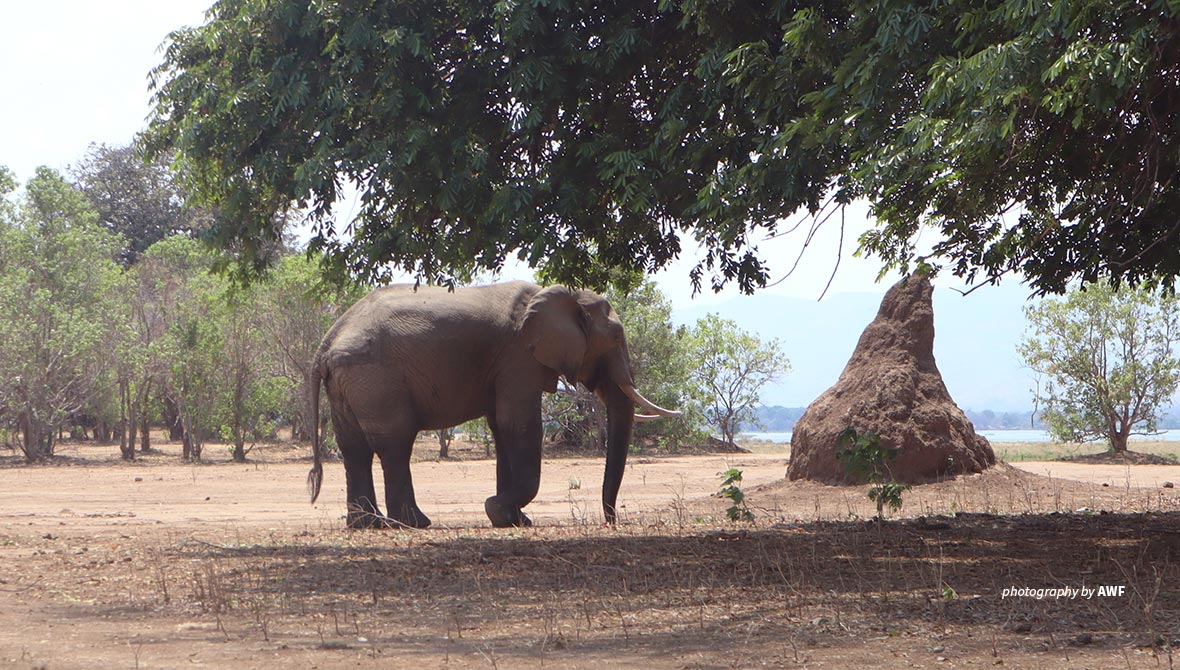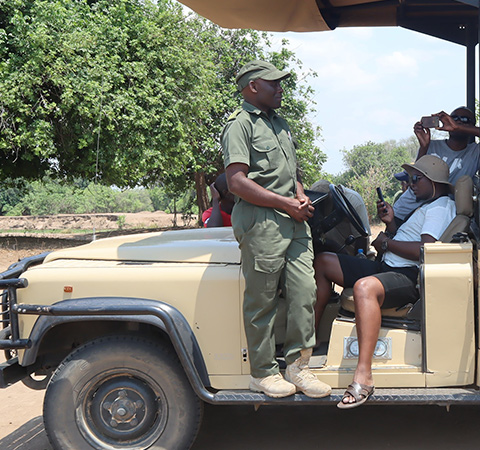Elephant poaching declines in Lower Zambezi Mana Pools Transfrontier Conservation Area

African elephant in Zimbabwe's Mana Pools National Park
May 26, 2023 is an important day in Zimbabwe and Zambia’s conservation history following the signing of the Lower Zambezi Mana Pools Transfrontier Conservation Area (LOZAMAP TFCA) Memorandum of Understanding between the two countries. Zimbabwe’s Minister of Environment, Climate, Tourism, and Hospitality Industry, Honorable Nqobizita Mangaliso Ndlovu, and the Zambian Minister of Tourism, Honorable Rodney Sikumba, signed the agreement at a historic event held in Harare, Zimbabwe’s capital.
The MoU, among other elements, seeks to set up forums for development, foster transnational collaboration in implementing ecosystem management, and enhance ecosystem integrity and natural ecological processes by harmonizing environmental management procedures.
Although the LOZAMAP TFCA agreement was signed recently, various efforts from development partners, including the African Wildlife Foundation (AWF) and the Zimbabwe Parks and Wildlife Management Authority (Zimparks), have contributed immensely to elephant conservation in the landscape. The landscape is richly endowed with the African elephant (Loxodonta africana), among other iconic wildlife species.
Following the decline of the elephant population over several decades due to poaching and habitat loss, the species was listed as endangered on the International Union for Conservation of Nature’s (IUCN) Red List of Threatened Species. The African elephant populations of Zimbabwe, Botswana, Namibia, and South Africa are included in Appendix II of the Convention on International Trade in Endangered Species of Wild Fauna and Flora which includes species not necessarily threatened with extinction, but for which trade must be controlled to avoid utilization incompatible with their survival.

Zimparks Mana Pools Senior Area Manager, Edmore Ngosi
Conserving the African elephant
In honor of World Elephant Day 2023, commemorated on August 12 to observe the protection of the world's elephants, we interviewed the Zimparks Mana Pools Senior Area Manager, Edmore Ngosi and the Lower Zambezi (Zambia) Area Manager, Patrick Mulenga to understand more about elephant conservation in the LOZAMAP TFCA area. Ngosi and Mulenga confirm that there has been a decline in elephant poaching in the landscape’s protected areas owing to various interventions by law enforcement authorities.
“Elephant poaching has greatly decreased in recent years with Mana Pools, Chewore and Sapi recording zero elephant poaching for the past four years. However, Hurungwe Safari area has recorded 3 carcasses linked to poaching since 2020,” Ngosi said. “Comparing these statistics with the records for periods before 2020, it shows that elephant poaching has been successfully curbed though there is need to maintain and improve the security to guarantee long lasting successful protection of elephants within the LOZAMAP TFCA area,” he cautioned.
The Zambian ecologist concurred: “Elephant poaching in the LOZAMAP TFCA area has reduced compared to the previous years. The evidence of continued decline in elephant poaching is proof that efforts by enforcement authorities are having an impact on the ground.”
The two conservationists observed the important role being played by cross-border collaborations between Zimbabwe and Zambia law enforcement agencies as far as elephant and other species conservation is concerned. Mulenga believes that two heads are better than one, and collaborating to fight poaching has contributed to the decline of elephant poaching.
Zimparks Mana Pools Senior Area Manager’s opinion is that cross-border collaboration meetings, patrols, and sporting programs have cemented and improved conservation relations between Zimbabwe and Zambia. In particular, cross-border meetings facilitate information sharing which has widened informer networks within the LOZAMAP TFCA, signaling that law enforcement agents in both countries are working together to reduce poaching.
“Communities, that is, fishermen, on the Zambian side are now buying into the conservation efforts because of the joint river patrols and awareness programs that are conducted jointly by the two countries,” notes Ngosi. “Cross-border collaboration has allowed for an integrated conservation approach in the landscape that goes beyond national boundaries, as a result, reducing habitat fragmentation and isolation.”
AWF supports cross-border collaboration for conservation
With funding from the CITES Monitoring the Illegal Killing of Elephants (MIKE) and the Dorothy Batten Foundation, AWF, in partnership with Zimparks, has been supporting meetings and providing anti-poaching support through fuel and patrol rations in the Mid Zambezi Valley Landscape which is within the LOZAMAP TFCA area.
“AWF in partnership with Zimparks has played a major role in organizing and funding cross-border programmes within the LOZAMAP TFCA creating a collaborative action between the two countries to curb elephant poaching in the area,” Ngosi said. “Furthermore, AWF has significantly contributed towards community outreach programmes through sponsoring the activities, thereby improving the relations between protected areas authorities and the communities living adjacent to these areas.”

Lower Zambezi (Zambia) Area Manager, Patrick Mulenga
Mulenga also paid tribute to AWF for contributing to the decline of elephant poaching in the LOZAMAP TFCA area, through providing anti-poaching equipment, building camps, providing transport, and supporting investigations, community outreach programs, and training.
The AWF-Zimparks partnership has also supported infrastructure development through the setting up of the Zambezi River Specialised Anti-Poaching Unit (ZARSAU), investing in modern technologies through the donation of data collection equipment for ranger-based monitoring, including ruggedized devices with the Spatial Monitoring and Reporting Tool (SMART), CyberTrackers, laptops, and TV screens for data presentations and facilitating digital radio communication system installation. Additionally, they have provided anti-poaching vehicles for field operations.
“The establishment of a permanent river unit for anti-poaching purposes known as ZARSAU has been a great achievement from AWF in partnership with Zimparks; this unit has been effective in deterring poachers,” Ngosi elaborated. “SMART is playing a critical role in the Monitoring of Illegal Killing of Elephants program within Mana Pools National Park and Chewore Safari area by recording, storing, and analyzing all information [such as] elephant mortality, whether illegal or natural death, number of patrols and patrol coverage.”
The battle against elephant poaching within the LOZAMAP TFCA is not yet over. Ngosi and Mulenga have identified some of the priority areas that should not be left out as part of interventions on elephant species conservation. They are optimistic that research, outreach programs to communities, and boosting support to the ranger workforce can strengthen elephant anti-poaching interventions within the landscape.
According to Mulenga, research is an important section that needs support, “AWF supported our collaborative hippo count last year which was successful. [We are] looking forward to more collaborative research, especially on elephants.”
“Scientific research needs adequate attention and support to protect elephants as the threat might not always be from poaching, for example diseases (affecting reproduction) and drought might also affect elephant population,” Ngosi concurred.
In his speech during the signing of the LOZAMAP TFCA MoU, Minister Ndlovu highlighted that the initiative is not a new area of cooperation but an opportunity to scale up Zimbabwe and Zambia's collaboration which has been ongoing, bringing on board more beneficiaries as local communities take ownership of projects. He thanked development partners including AWF, Peace Parks Foundation, the U.N. Development Programme, and the Global Environmental Facility GEF-6 project for directly assisting the Zimbabwe component of the TFCA.
As we continue to strengthen landscape conservation efforts, we hope that the partnership between AWF and Zimparks will continue to yield positive results in the LOZAMAP TFCA landscape and contribute sustainably to species population recovery.